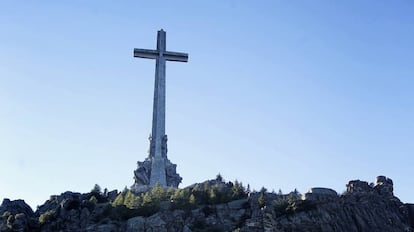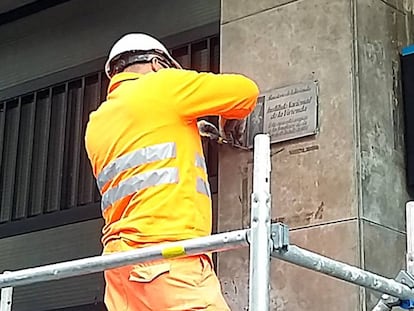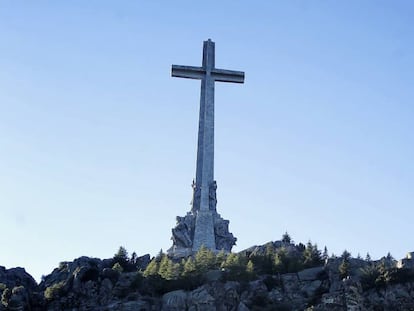Spanish government fails to remove single Franco-era symbol in five years
Last such removal from public institutions was in April 2011 during Socialist legislature
Opposition parties in Spain are calling for answers as to why the conservative Popular Party (PP) government of Spain has not removed a single existing symbol of the era of former Spanish dictator Francisco Franco from ministries and other public institutions since coming to power in December 2011.

The removal of these vestiges of Franco’s deeply divisive rule is mandated by Spain’s Historical Memory Law. Passed by the former Socialist Party (PSOE) government of José Luis Rodríguez Zapatero in 2007, the law made provision for the removal of statues and the changing of place names connected to Franco’s regime – legislation that was aimed at providing moral redress for the victims of Spain’s bitter Civil War and the long dictatorship that followed.
The Spanish government says red tape and costs are to blame for delays
Under the Socialists, 570 of a total of 705 symbols catalogued by a commission charged with the job were removed but the process ground to a halt in April 2011 and there has been no movement since the conservative PP won general elections in November 2011.
Recently a senator with the Basque nationalist party EH Bildu, Jon Iñarritu, called on the government to explain this five-year halt and the PP responded by citing red tape and high costs.
“Which Francoist vestiges have been taken down from ministries and public institutions since 2012?” asked Iñarritu in a written question to the Spanish government, in which the senator also asked about the planned timetable for the removal of the remaining 135 symbols of the dictatorship.
The PP responded on February 27 saying that the “remainder of the [symbols] are currently being processed, either because they are the subject of an administrative process or because of the cost involved.”
Under the Socialists, 570 of a total of 705 Francoist symbols were removed
The question from Iñarritu comes a month after Spain’s main opposition party, the PSOE, called for Franco’s remains to be removed from the controversial Valley of the Fallen site outside Madrid.
That demand – part of a push by the PSOE to stop perceived foot dragging on the part of the PP on implantation of the Historical Memory Law – was made in the wake of a government statement that the site is not a monument to Franco.
But the site contains just two marked graves: those of Franco and José Antonio Primo de Rivera, the founder of the Falange, Spain’s fascist-inspired political party. At the same time, thousands of prisoners of war who fought against Franco in the civil conflict were among the workforce used in its construction.
English version by George Mills.
Tu suscripción se está usando en otro dispositivo
¿Quieres añadir otro usuario a tu suscripción?
Si continúas leyendo en este dispositivo, no se podrá leer en el otro.
FlechaTu suscripción se está usando en otro dispositivo y solo puedes acceder a EL PAÍS desde un dispositivo a la vez.
Si quieres compartir tu cuenta, cambia tu suscripción a la modalidad Premium, así podrás añadir otro usuario. Cada uno accederá con su propia cuenta de email, lo que os permitirá personalizar vuestra experiencia en EL PAÍS.
¿Tienes una suscripción de empresa? Accede aquí para contratar más cuentas.
En el caso de no saber quién está usando tu cuenta, te recomendamos cambiar tu contraseña aquí.
Si decides continuar compartiendo tu cuenta, este mensaje se mostrará en tu dispositivo y en el de la otra persona que está usando tu cuenta de forma indefinida, afectando a tu experiencia de lectura. Puedes consultar aquí los términos y condiciones de la suscripción digital.
More information
Últimas noticias
The complicated life of Francesca Albanese: A rising figure in Italy but barred from every bank by Trump’s sanctions
Half of Scotland is in the hands of 420 property owners
Pinochet’s victims grapple with José Antonio Kast’s rise in Chile
Reinhard Genzel, Nobel laureate in physics: ‘One-minute videos will never give you the truth’
Most viewed
- Pablo Escobar’s hippos: A serious environmental problem, 40 years on
- Why we lost the habit of sleeping in two segments and how that changed our sense of time
- Charles Dubouloz, mountaineering star, retires at 36 with a farewell tour inspired by Walter Bonatti
- Trump’s obsession with putting his name on everything is unprecedented in the United States
- The Florida Keys tourist paradise is besieged by immigration agents: ‘We’ve never seen anything like this’











































